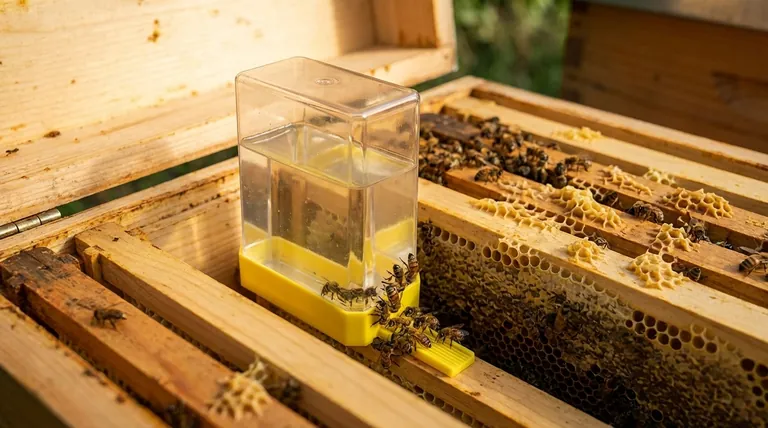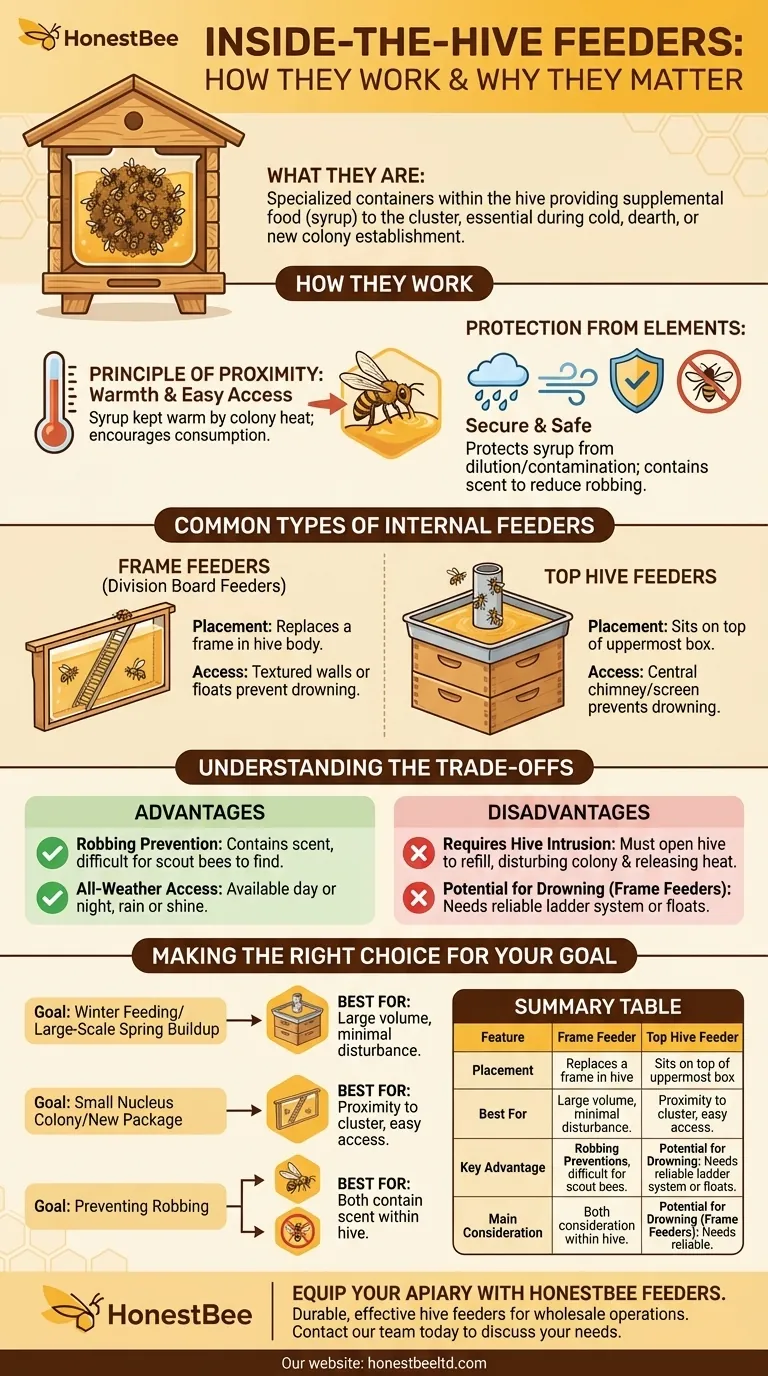At their core, inside-the-hive feeders are specialized containers placed directly within the beehive to provide supplemental food, most commonly sugar syrup. They are designed to give bees easy and protected access to nourishment without forcing them to leave the hive, which is critical during cold weather, periods of nectar dearth, or when establishing a new colony.
The fundamental advantage of inside-the-hive feeders is their ability to deliver food directly to the bee cluster while minimizing risks. By keeping the food source within the hive, you reduce drowning, robbing from other colonies, and exposure to the elements, making it one of the safest feeding methods.

How Inside-the-Hive Feeders Work
The primary function of an internal feeder is to place a food source as close to the bees as possible in a protected environment. This encourages consumption and reduces the energy bees must expend to get food.
The Principle of Proximity
By being inside the hive, the syrup is kept warm by the colony's ambient heat. This makes it more appealing and easier for the bees to consume, especially in cooler temperatures when they are reluctant to travel far.
Protection from the Elements
Unlike external feeders, an internal feeder protects the sugar syrup from being diluted by rain or contaminated by debris. It also contains the scent of the syrup, drastically reducing the risk of "robbing," where bees from other, stronger hives attack a weaker hive to steal its resources.
Common Types of Internal Feeders
There are several designs, each fitting into a different part of the hive.
Frame Feeders (or Division Board Feeders): These are thin, tank-like feeders, typically made of plastic, that are built to the same dimensions as a standard hive frame. A beekeeper removes one or two frames from the hive body and hangs the feeder in their place.
These feeders often have textured interior walls or require the addition of "floats" (like cork, wood, or plastic ladders) to give bees a surface to stand on and prevent them from drowning in the syrup.
Top Hive Feeders: These large-volume feeders sit directly on top of the uppermost hive box, but underneath the main hive cover. Bees access the syrup by climbing up through a central chimney or screen, keeping them separated from the main reservoir of liquid and virtually eliminating the risk of drowning.
Understanding the Trade-offs
While highly effective, internal feeders are not without their own set of considerations. Understanding these trade-offs is key to using them 성공적으로.
Advantage: Robbing Prevention
This is the most significant benefit. Because the food source is contained entirely within the hive, it is much more difficult for scout bees from other colonies to discover and trigger a robbing event, which can decimate a weak colony.
Advantage: All-Weather Access
Bees can access an internal feeder दिन हो या रात, in rain or cool weather. This is a stark contrast to external feeders, which bees cannot use in poor conditions.
Disadvantage: Requires Hive Intrusion
The primary drawback is that you must open the hive to check the syrup level and refill the feeder. This disturbs the colony, breaks the propolis seal, and releases heat, which can be stressful for the bees, especially in cold weather.
Disadvantage: Potential for Drowning
With frame feeders specifically, there is a risk of bees drowning if proper precautions are not taken. Always ensure your frame feeder has a reliable ladder system or add your own floats to provide safe access for the bees.
Making the Right Choice for Your Goal
The best internal feeder depends entirely on your specific objective and the condition of your colony.
- If your primary focus is emergency winter feeding or large-scale spring buildup: A top hive feeder is ideal, as it holds a large volume of syrup and minimizes the frequency of hive-opening disturbances.
- If your primary focus is feeding a small nucleus colony or a new package of bees: A frame feeder is an excellent choice because it sits right beside the cluster, making it incredibly easy for a small population of bees to access.
- If your primary focus is preventing robbing in your apiary: Any type of internal feeder is vastly superior to an external entrance feeder, as it contains the food scent within the hive.
Ultimately, selecting the right internal feeder is about balancing the colony's needs with the beekeeper's goal of minimal intrusion.
Summary Table:
| Feature | Frame Feeder | Top Hive Feeder |
|---|---|---|
| Placement | Replaces a frame in the hive body | Sits on top of the uppermost box |
| Best For | Small nucs, new packages | Winter feeding, large-scale spring buildup |
| Key Advantage | Proximity to the bee cluster | Large volume, minimal disturbance |
| Main Consideration | Risk of drowning (needs ladder/floats) | Requires lifting the hive cover to refill |
Equip your apiary with the right feeding solutions from HONESTBEE.
Our wholesale-focused operations supply commercial apiaries and beekeeping equipment distributors with durable, effective hive feeders designed for success. Whether you need reliable frame feeders for new colonies or high-capacity top feeders for large-scale operations, we provide the equipment to support healthy, productive bees.
Contact our team today to discuss your wholesale needs and discover how our supplies can strengthen your beekeeping business.
Visual Guide

Related Products
- Professional Hive Front Entrance Bee Feeder
- Boardman Entrance Bee Feeder Durable Galvanized Steel and Wood Construction for Beekeeping
- HONESTBEE Professional Entrance Bee Feeder Hive Nutrition Solution
- In-Hive Dual Compartment Frame Bee Feeder for Targeted Colony Nutrition
- Classic Boardman Entrance Bee Feeder Hive Front Feeding Solution
People Also Ask
- What is an entrance feeder? A Guide to Its Simple Design and High Robbing Risk
- How does the entrance feeder method work? A Guide to Simple But Risky Hive Feeding
- How to make an entrance feeder for bees? A DIY Guide for Safe & Effective Feeding
- What is an entrance feeder and how is it used? Avoid the Critical Risk of Robbing
- Are entrance feeders good for bees? Prioritize Hive Health Over Convenience



















